Jul 1, 2025 – INEB Day 6, Funeral Service for the Late Dharma Teacher Myohyang, Silsangsa Temple, Activities with the Local Community
Hello. Today is the 6th day of the INEB Study Tour. After attending the funeral service for the late Dharma Teacher Myohyang at the Jungto Social and Cultural Center and giving a Dharma talk, Sunim traveled to Silsangsa Temple. In the afternoon, he had a dialogue with the INEB Jungto Society delegation at Silsangsa Temple on the theme of “Activities with the Local Community.”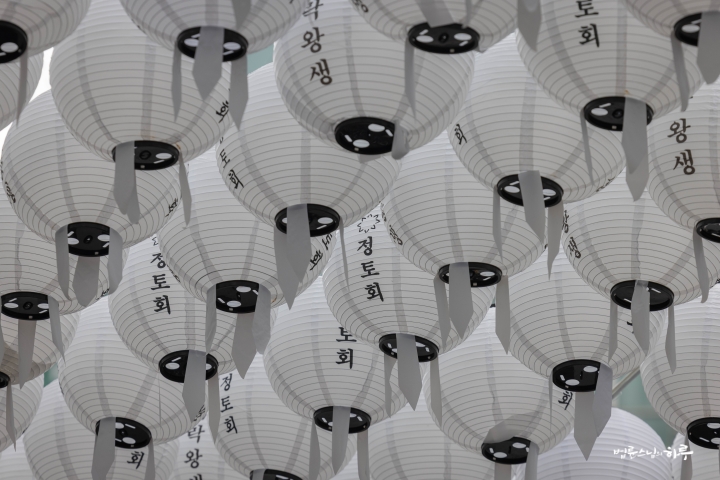
After completing morning practice and meditation, Sunim headed to the Jungto Social and Cultural Center. At 7:30 AM, the funeral service for the late Dharma Teacher Myohyang began in the Dharma Hall on the 3rd floor.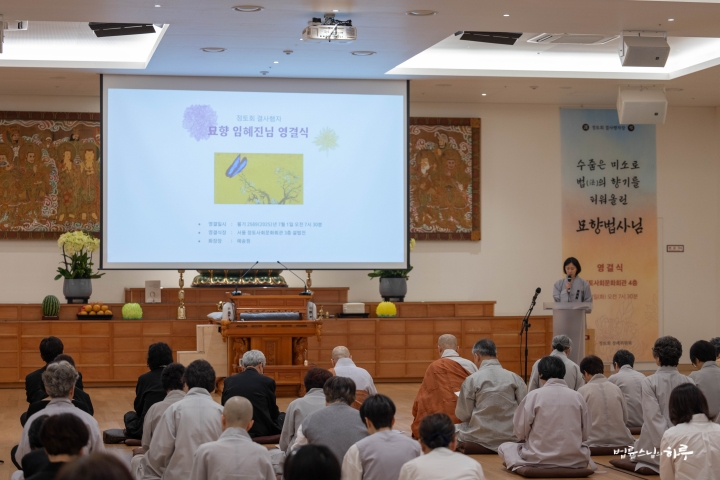
After reciting the Three Refuges and the Heart Sutra, family members first offered flowers at the memorial altar. Then the President of Jungto Society and the National Dharma Teachers’ Group Leader offered flowers in turn.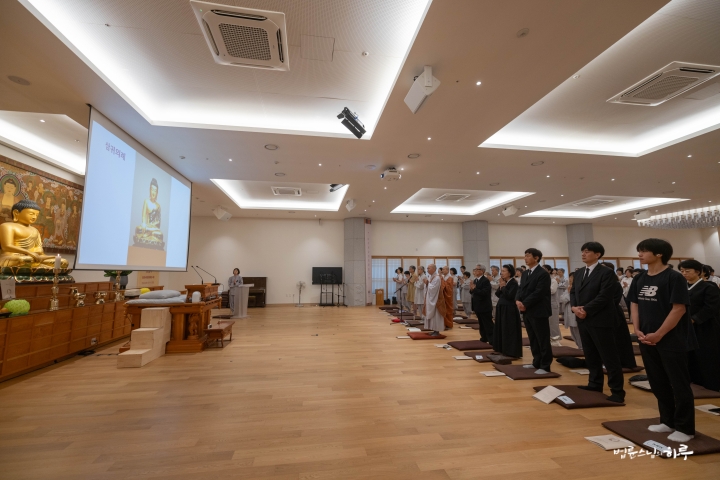
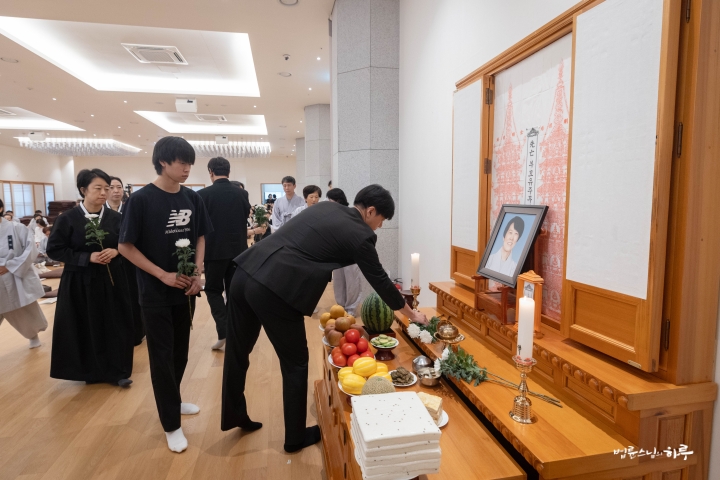
Next, everyone watched a video showing the life journey of Gyeolsa Practitioner (Lead Jungto Practitioner) Dharma Teacher Myohyang.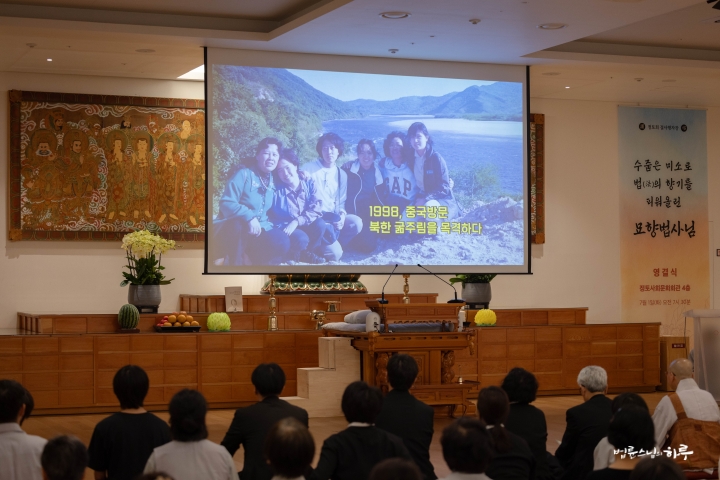
When the video ended, sobbing could be heard from various places, and many shed hot tears, grieving the parting with Dharma Teacher Myohyang.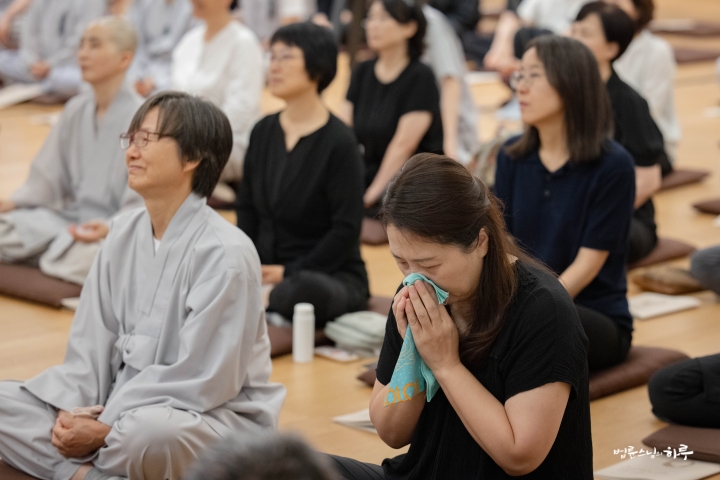
Then Venerable Yusu gave remarks for the assembly attending the funeral service.
“First, I would like to thank the parents who raised Dharma Teacher Myohyang so well…”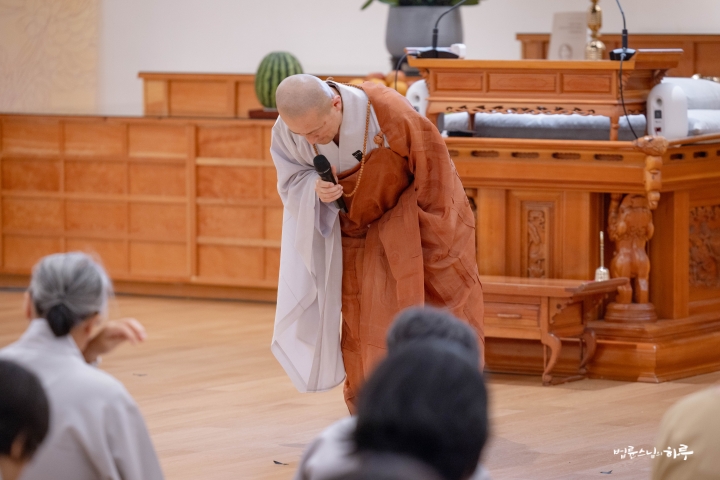
Venerable Yusu momentarily choked up and stopped speaking. Soon regaining composure, he continued calmly.
“I also met Dharma Teacher Myohyang when she was twenty years old in her first year of university, and we have been working together since then. I would like to thank all the members of the assembly who attended today.”
Next, the moderator read a letter that Dharma Teacher Myohyang had sent to Venerable Pomnyun Sunim during her cancer treatment.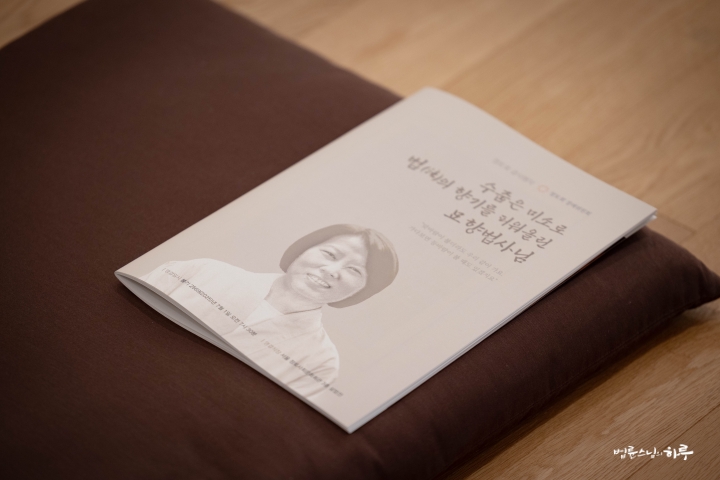
“Sunim, the bright afternoon sky fills the hospital window. The street trees have shaken off all the snow and somehow seem to be blooming softly. Spring must be coming. The lady in the next bed and the grandmother who was diagonally across have gone to nursing homes or other wards, and sitting in this quiet hospital room, gratitude washes over me. Even when I was in shock from chemotherapy, even when I had no strength and couldn’t drink water and was completely parched, Sunim and fellow practitioners sent endless comfort and encouragement. I feel indescribable gratitude and the preciousness of existence. Feeling that I can be happy just by being alive, I look back on my life.
The fellow practitioner who moves me whenever she thinks of it to prevent bedsores, the fellow practitioner who lifts my pelvis that’s more than twice her body weight because my body gets stiff after just an hour, the attending physician who sets goals so I can eat, the nurses who check and care for me every hour – I am grateful for everyone.
Sunim, the people jogging side by side on the walking path don’t make me envious like before. Now, when I have the opportunity to live a new life completely given to me, I am sufficient and grateful as I am. I like myself now – defecating, walking around the hospital room with a stepper, doing clumsy exercises while holding onto the oxygen tank. Even with a face like an anchovy and a body that seems about to break, I truly cherish myself now, able to feel the gratitude of this world. I’m off oxygen today and trying some porridge to test my swallowing. Each day is incomparably new and precious. I am joyful to have encountered the Buddha’s Dharma, and I am grateful for Sunim’s grace.”
The moderator then read Venerable Pomnyun Sunim’s reply to Dharma Teacher Myohyang’s letter.
“Life is simply being alive here and now. There is nothing to be indebted for. We are merely the hands and feet of one body. This is the merit that Dharma Teacher has accumulated.”
Each brief word became a deep resonance that permeated everyone’s hearts.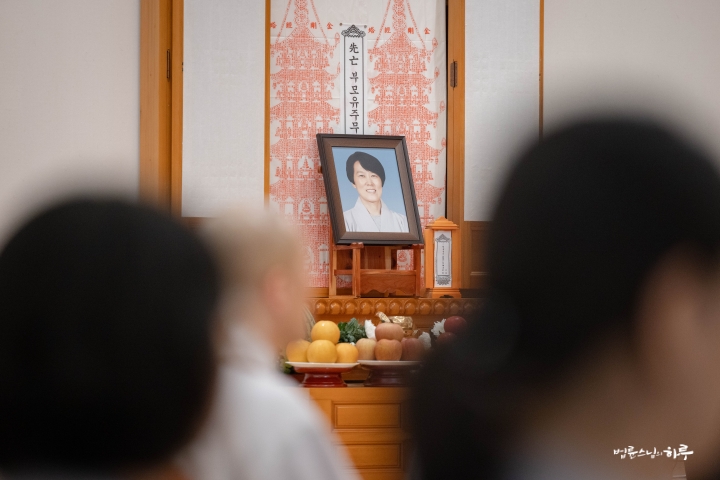
Next, Dharma Teacher Mubyeonsim gave a memorial address.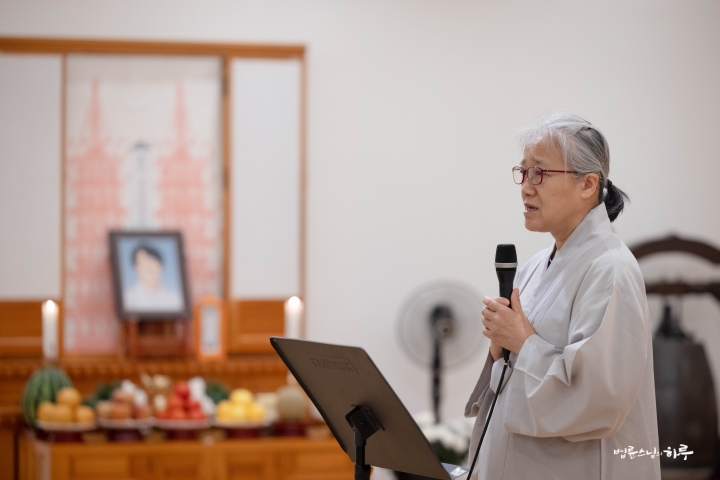
“First, I would like to express my deepest gratitude to the parents for raising our beautiful Dharma Teacher Myohyang so well and sending her to us. Thanks to you, we were able to live well together with Dharma Teacher Myohyang. Dharma Teacher Myohyang was a very quiet person who never put herself forward. She did whatever task was given to her if it was necessary, not because she was confident in herself. Though she always lived quietly and inconspicuously, she always carried out her responsibilities silently. Even when facing death due to illness, seeing her maintain equanimity, I could feel that she was someone who embodied our guiding teacher’s teachings even with her sick body. Even in the hospital, she always took care of the nurses treating her and the people around her. Through Dharma Teacher Myohyang, we could see the Buddha’s example of caring for people until the very end. Even as a patient, she gave us many teachings. I hope we too can live freely and happily according to the teachings Dharma Teacher Myohyang showed us through her actions.”
Hearing the memorial address brought back memories of Dharma Teacher Myohyang’s life, making hearts heavy with emotion.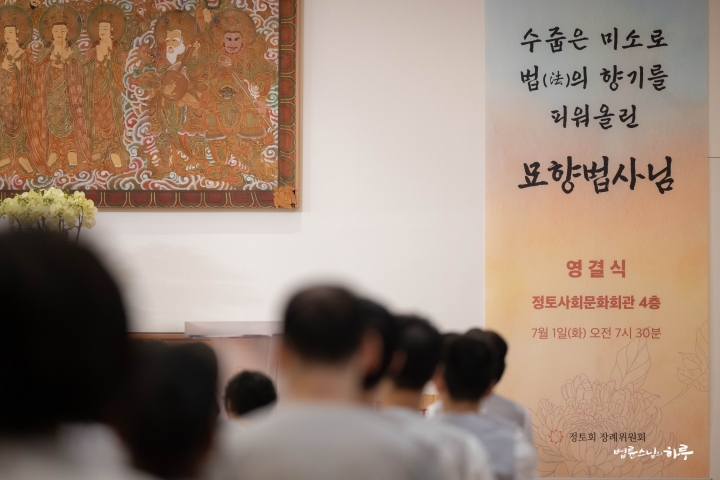
The attending assembly then requested a Dharma talk from Sunim with three prostrations. Sunim consoled the parents and fellow practitioners who couldn’t contain their grief, while speaking about how meaningful and beautiful the life Dharma Teacher Myohyang had lived was.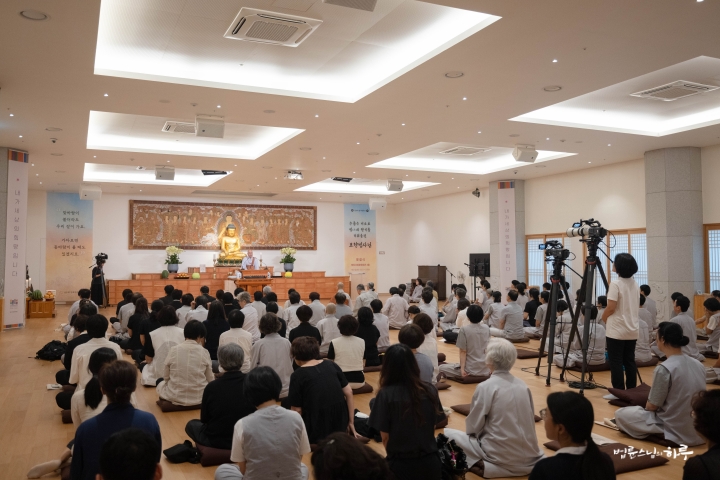
“Today is the day when Dharma Teacher Myohyang Im Hye-jin, who has lived with us as a member of the practicing Sangha for the past thirty years, departs for the path of nirvana where there is no more suffering or bondage. From the perspective of the affection we’ve shared for thirty years, the sense of loss must be great, but if the place Dharma Teacher is going is the path of nirvana, we need not grieve excessively. However, since we are still in the process of practice, we cannot completely let go of our attachments. Rather than the good place she is going to, our sense of loss at her leaving us is greater, and this manifests as grief.
Dharma Teacher Myohyang, May You Go Peacefully on the Path to Nirvana Free from Suffering
First, I would like to say a few words to Dharma Teacher Myohyang Im Hye-jin who is departing before us. Dharma Teacher, you have worked so hard. From the tender age of twenty as a fresh university student, you took refuge in the Buddha’s Dharma and have lived as a practitioner for thirty years until today. Looking at your life journey in light of the Buddha’s teachings, you must have known that life is originally something that cannot go even if it tries to go, cannot come even if it tries to come. From a religious perspective, when we say “going,” you must have gone directly to the Pure Land where Amitabha Buddha resides. And when we say “coming,” you will not come to this world helplessly due to karmic connections created by sentient beings as in past lives, but will manifest as a bodhisattva in this land for the sake of family, relatives, friends, and many people connected through your bodhisattva vow.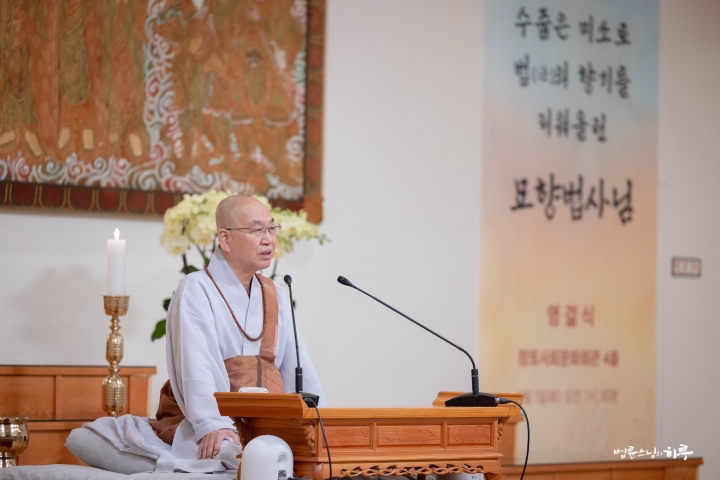
If we think only of Dharma Teacher, there is actually no need for us to hold such an elaborate funeral and observe the 49-day memorial service. However, we who cannot accept parting have not yet reached that level of realization, so the regret of letting go becomes grief that weighs heavily on our hearts. Therefore, even though it may be troublesome for Dharma Teacher, I ask that you visit us each time we hold a memorial service and postpone your journey to the Pure Land for a while to be with us, for the sake of your family and fellow practitioners who seek to ease the sorrow of parting.
There is an old saying: ‘When parents die, bury them in the ground; when children die, bury them in your heart.’ This is because parents have given birth to and raised their children, so no matter how much the children grow and age, they always remain as little children in their parents’ hearts. That’s why it’s said they cannot let go and bury them in their hearts. Today, Dharma Teacher Myohyang’s mother and father must be struggling to steady themselves with deeper regret and sorrow than anyone else. How could words provide comfort? However, though she may still seem like a child in your arms because she is your daughter, Dharma Teacher Myohyang actually entered this path of practice by her own judgment as soon as she became an adult at twenty, rather than being led by the world. For thirty years, she consistently practiced and worked for the peace and benefit of people in the world. From a parent’s perspective, there may be regrets, but from the world’s perspective, she did truly admirable and noble work. So I ask that you steady your hearts so as not to fall into grief from being unable to overcome regret, thinking only of the parent-child relationship. Of course, I also know well that such words cannot easily lighten a parent’s heart.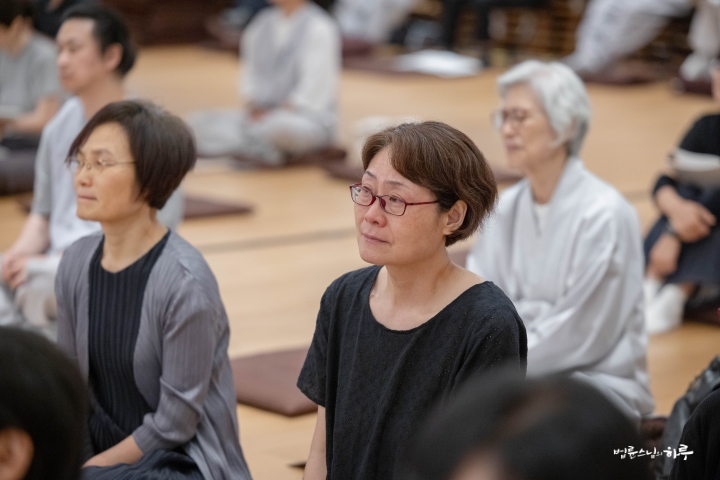
Even King Suddhodana, the father of the Buddha who is humanity’s teacher, could only see the Buddha as his son throughout his life, never as the Buddha. While many people in the world heard the Buddha’s teachings, attained enlightenment, and experienced the joy of liberation, King Suddhodana, blinded by his attachment, could not attain enlightenment until his death. From a worldly perspective, his love could be considered truly profound. However, from the perspective of practice, he could not cross the ocean of suffering because of his foolishness in failing to see the Buddha due to being caught up in attachment. If even King Suddhodana, who had the Buddha as his son, could not let go of his attachment in the end, how could ordinary parents remain detached in the face of their child’s death? Therefore, the inability to bear grief is completely understandable. However, upon further reflection, this also serves as a lesson in reverse. While attachment represents the greatest love from a worldly perspective, it becomes the biggest obstacle to opening the eyes of wisdom from the perspective of liberation. This is why one cannot escape from a foolish life of having eyes but not seeing, having ears but not hearing.
I hope you will take these points to heart once again. Although she was your child, she had already left home to become a practitioner, and as a Dharma Teacher, she rose to the ranks of teachers respected by people in the world. She was no longer an ordinary being helplessly living in the world, but a practitioner who determined her own life and remained consistently awakened even until the moment she closed her eyes. From the perspective of enlightenment, there is nowhere to go and nowhere to come from, but if we speak of going somewhere, she will surely be in the Pure Land. Therefore, please do not grieve too much and willingly send off Dharma Teacher Myohyang, who is departing for a better place, with a light heart. 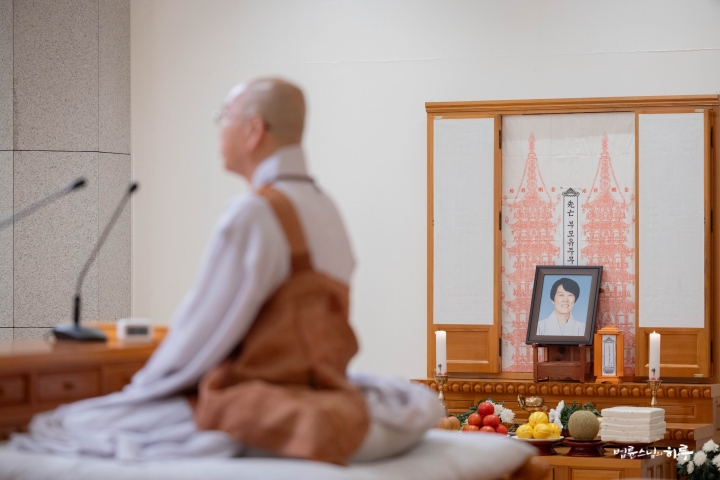
Learning Practice from the Empty Seat of a Fellow Practitioner
To all members of the Sangha who have practiced together, Dharma Teacher Myohyang was born into her parents’ embrace and lived with her family until she became an adult at twenty. Upon entering university as an adult, she formed a connection with the Buddha’s teachings, and not long after, she joined our community and has been with us ever since. It has been 30 years since she first encountered the Dharma, and over 25 years since she began living in the community. We can now say that the days she has lived with us as a new family in the community are longer than the days she spent with her birth family.
Although we live together as practitioners and fellow Dharma friends, we have not yet completely let go of our attachments and have not become unhindered practitioners. Through the various connections we formed with the Dharma Teacher, friendships have developed. We also made vows together and promised to move forward. Dharma Teacher Myohyang was one of the youngest among the Jungto Society Dharma Teachers. As someone who was expected to be a central figure in leading Jungto Society’s second 10,000-Day Practice, I understand that your sense of loss must be even greater.
However, we must live according to our karmic connections. No matter how grand our goals or how firmly we promised to work together, when unknown karmic conditions arise, we must follow them. No matter how beautiful autumn may be, we must accept winter when it comes, and no matter how pleasant the warmth of spring, we cannot resist the arrival of summer. Thus, no one in this world can go against the principle of karmic connections forming and dispersing. 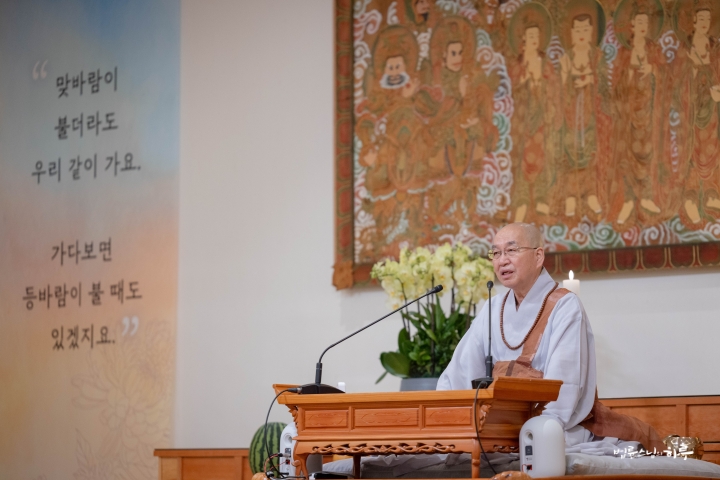
The path that the Dharma Teacher took was a good path, and throughout her life, she embraced abundant happiness just by being herself. Therefore, although we feel a sense of loss in our hearts, we must now willingly take on the work that the Dharma Teacher could not complete. We must live without clinging to each day, being grateful for being alive and living happily. When we do so, we will be able to enjoy the bliss of nirvana even while possessing this body, not only when we abandon it. From the fragrance that the Dharma Teacher left behind, we gain this precious lesson.
With worldly affection, it is truly difficult to let go, and the sorrow of parting is hard to bear. However, we are practitioners. We must always keep in our hearts the principles of impermanence (諸行無常) and non-self (諸法無我), and willingly accept these partings and farewells. Even if we cannot let go of the lingering regret and deep affection in our hearts all at once today, I hope we can release the bonds of karma one by one as we observe the 49-day memorial service.
When the Dharma Teacher was with us, her presence may not have seemed so significant. Now that she has departed, we realize how great the void she left behind truly is. We often fail to realize how precious and valuable each fellow practitioner by our side is, not just Dharma Teacher Myohyang. So that we don’t only feel the preciousness of our fellow practitioners after they leave and create an empty space, I hope we can realize their value while they are still beside us. Only then can we transform the lesson that Dharma Teacher Myohyang left us into practice, and all become greater practitioners.”
Listening to the Dharma talk, the members of the Sangha felt gratitude for the time they had shared with Dharma Teacher Myohyang and could once again appreciate the preciousness of those who are with them at this very moment.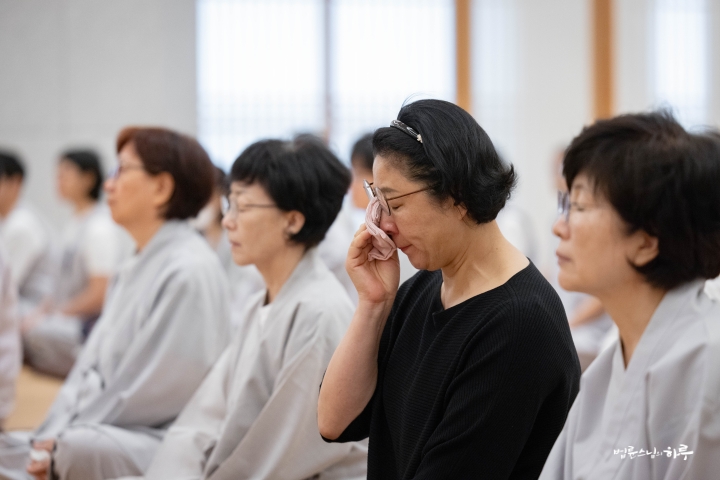
Next, Ms. Im Won-young, who had met Dharma Teacher Myohyang while volunteering during her time as Publishing Director, gave a memorial address. She was someone with whom Dharma Teacher Myohyang had shared such deep affection that she called her “aunt.”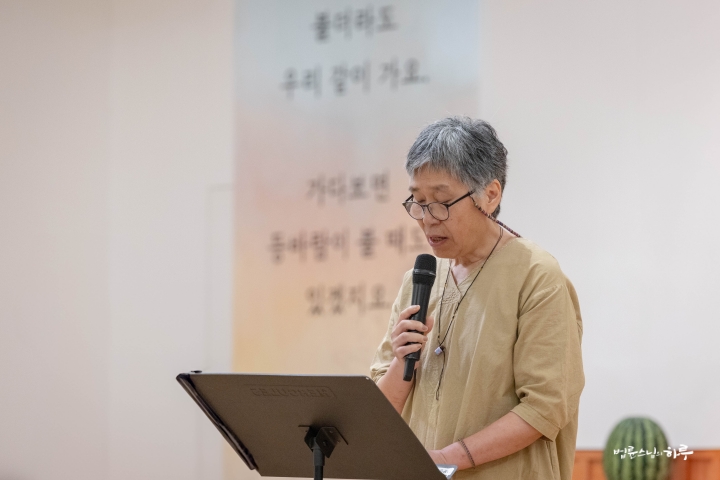
“Throughout her life, Hyejin was a pure practitioner, and even when death approached, she lived her daily life with equanimity. The unwavering composure she showed during her illness demonstrated to me the very teachings of the Diamond Sutra. Our Hyejin, Boeunhaeng, Cucumber Angel, Dharma Teacher Myohyang… Please rest a little in that place where you have gone, and then return to sentient beings like me as light again. I offer three prostrations to Dharma Teacher Myohyang with utmost sincerity.”
The memorial addresses continued as people remembered the warm-hearted Dharma Teacher Myohyang. Ms. Park Young-sook from the community, who had worked together since their university days, spoke about Dharma Teacher Myohyang who never forgot her warm smile.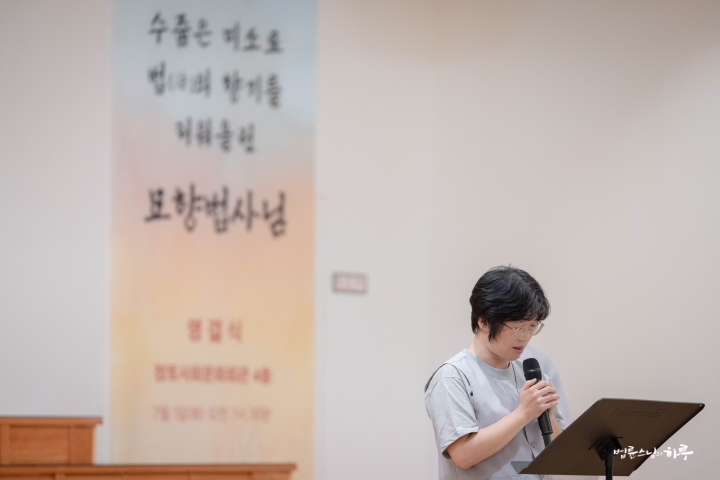
“In the summer of 1997, my heart was moved by Venerable Pomnyun Sunim’s earnest appeal, and I participated in the movement to help North Korean compatriots. It was there that I first met Dharma Teacher Myohyang. We spent that hot summer together conducting weekly street fundraising campaigns in front of Busan Station. Later, whether working together at Good Friends or in different departments, the Dharma Teacher was always my most comfortable fellow practitioner. Although the Dharma Teacher lived a short life, we will live our remaining lives adding her share to ours. Dharma Teacher Myohyang, please leave the remaining work to us and rest in peace. Thank you for all your hard work.”
Next, community members sang two songs that Dharma Teacher Myohyang had loved during her lifetime – Jang Pil-soon’s “When My Loneliness Calls You” and Kim Kwang-seok’s “With the Heart That I Must Forget.” As the songs resonated through the hall, the atmosphere became solemn once again.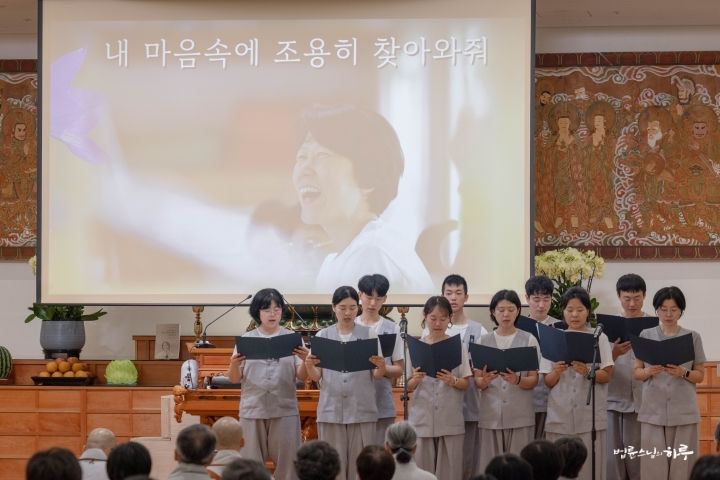
Many people’s eyes reddened as memories with Dharma Teacher Myohyang came flooding back with each lyric. Everyone hoped that Dharma Teacher Myohyang in heaven would listen with a joyful heart.
Following this, representing the chief mourners, Dharma Teacher Myohyang’s younger sibling gave remarks.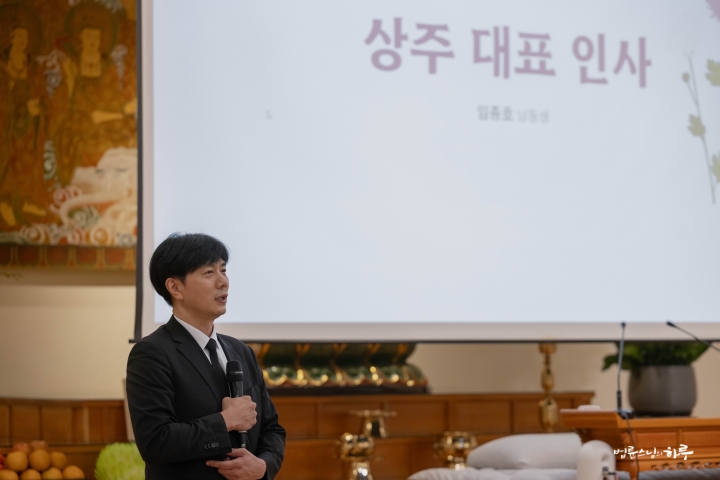
“When my sister first entered the temple, I often thought, ‘Why does she live like that?’ But listening to what all of you have said at today’s funeral service, I feel grateful knowing that my sister gave and received so much love with all of you. I believe the work she wanted to do will continue through your hands.”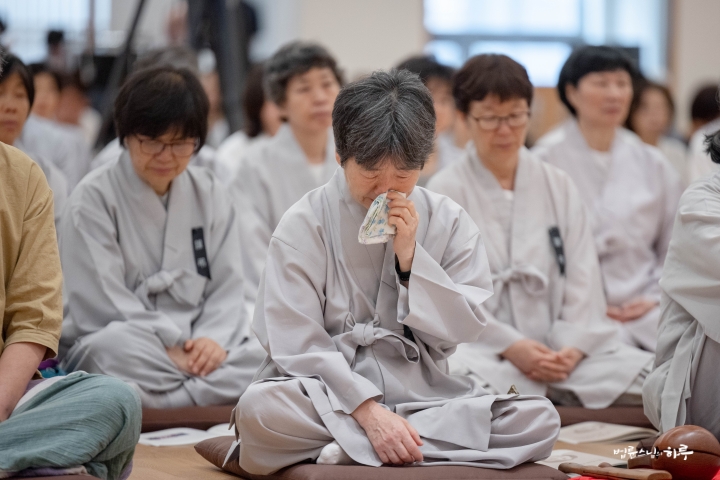
Many people shed tears. To send off the deceased peacefully, everyone sang together. Singing the song “I Hope It’s Like That Now,” which Dharma Teacher Myohyang had loved, everyone prayed for the deceased’s peace with one heart.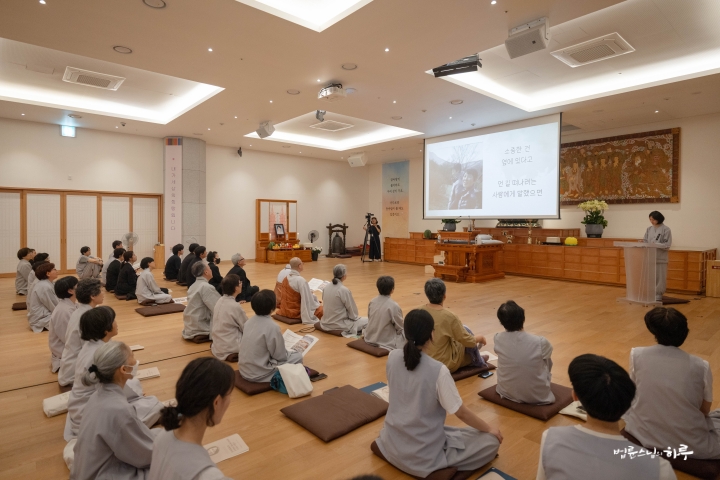
Finally, praying for the deceased’s rebirth in the Pure Land, they recited the Liberation Mantra three times, made three prostrations, and concluded the funeral service with the Four Great Vows.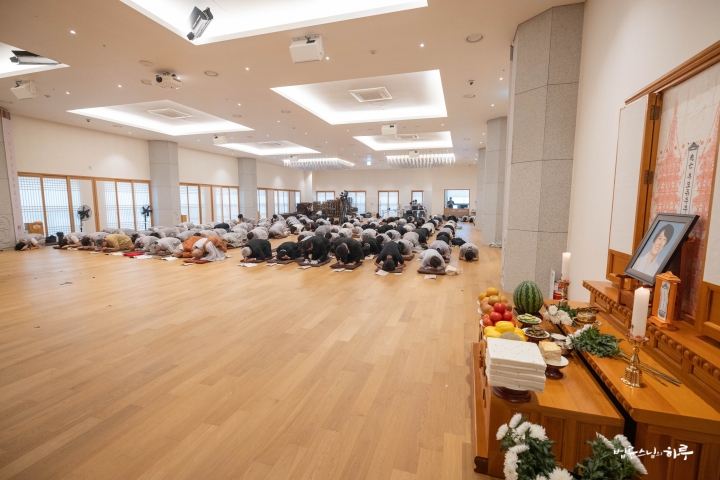
Sunim shook hands with the deceased’s family members, sincerely conveying his condolences before leaving the venue.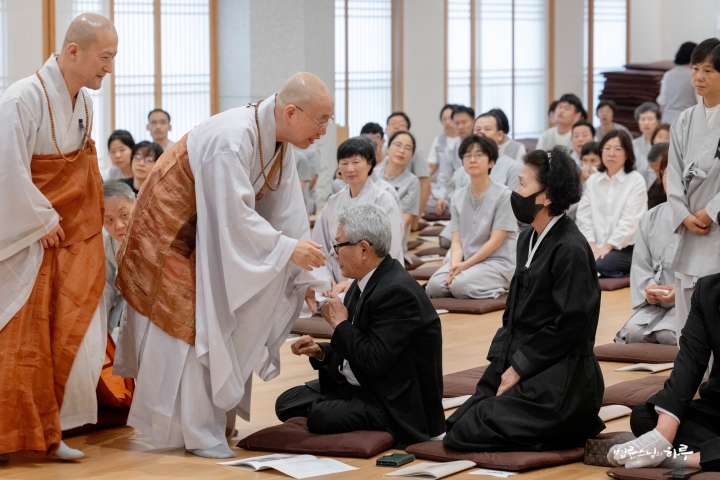
The family and fellow practitioners took a bus to the crematorium, while Sunim got in a car and headed to Silsangsa Temple on Mt. Jiri to participate in the INEB Study Tour program.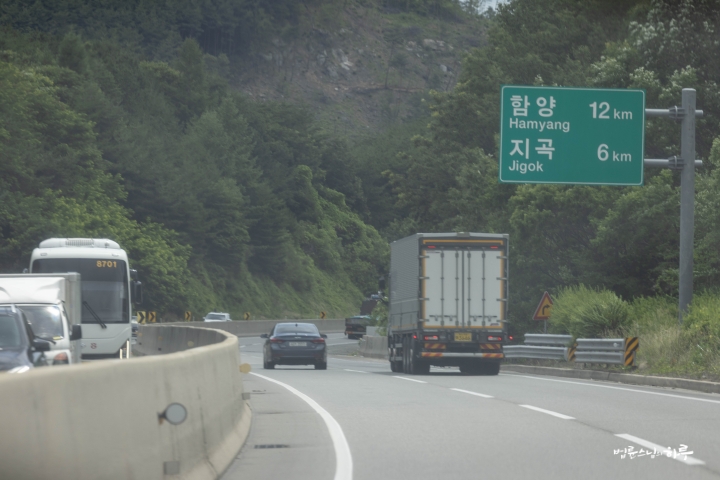
Departing from Seoul at 9 AM and traveling for 3 hours and 30 minutes, he arrived at Silsangsa Temple at 12:30 PM. When Sunim arrived, the INEB participants greeted him warmly.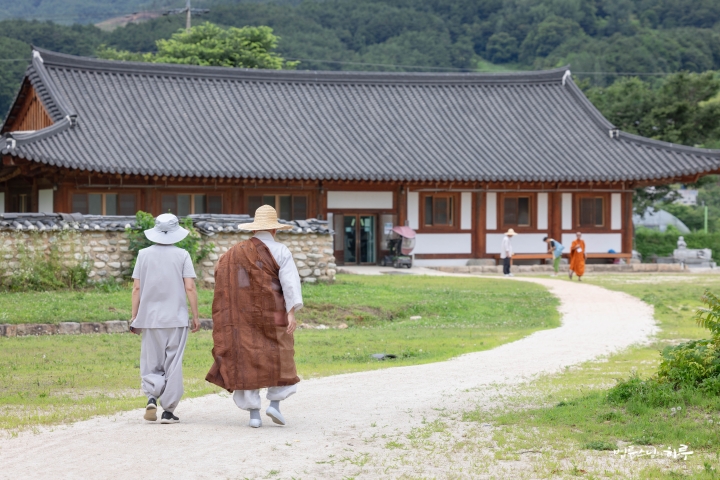
Sunim had lunch with Venerable Dobup, the spiritual leader of Silsangsa Temple, and then had tea and conversation. After discussing how to proceed with today’s program, they headed to Seonjae House where the event was being held.
Meanwhile, the INEB participant monks had spent the morning touring the Silsangsa community. After visiting the Silsangsa farm, Sannae Women Farmers’ Center, Workshop on Thu, Fri, Sat, Hwarimwon, Silsangsa Small School, One Life, and Sumdanji Fermentation Research Institute in order, they arrived at Seonjae House.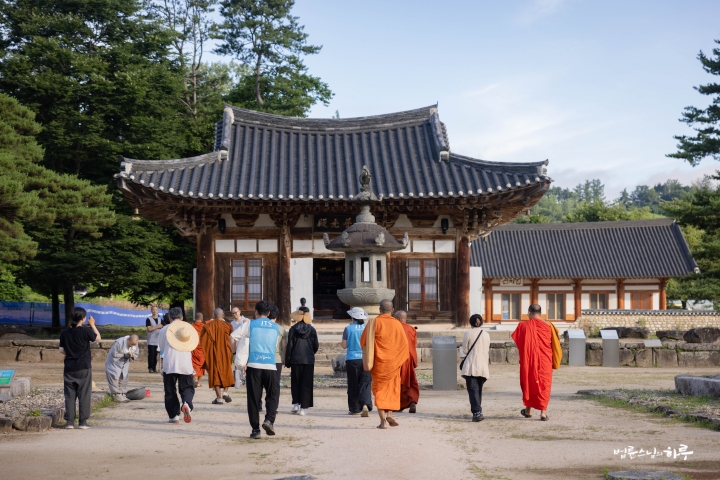
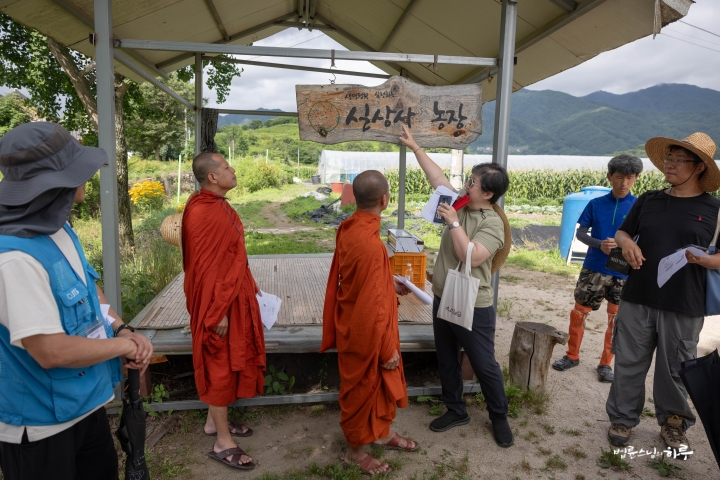
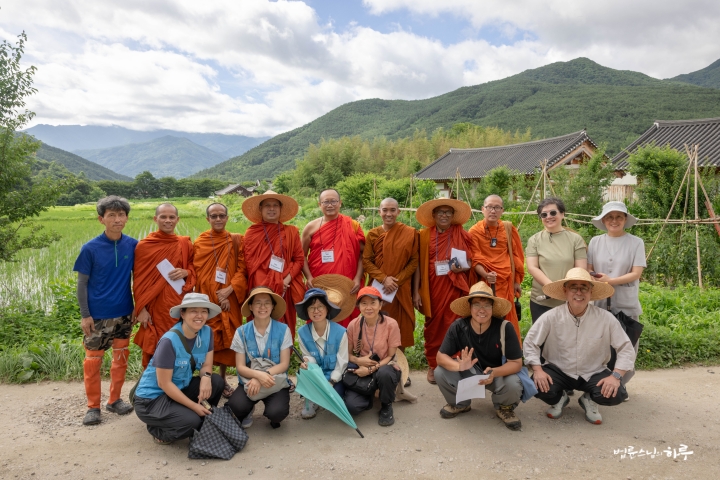
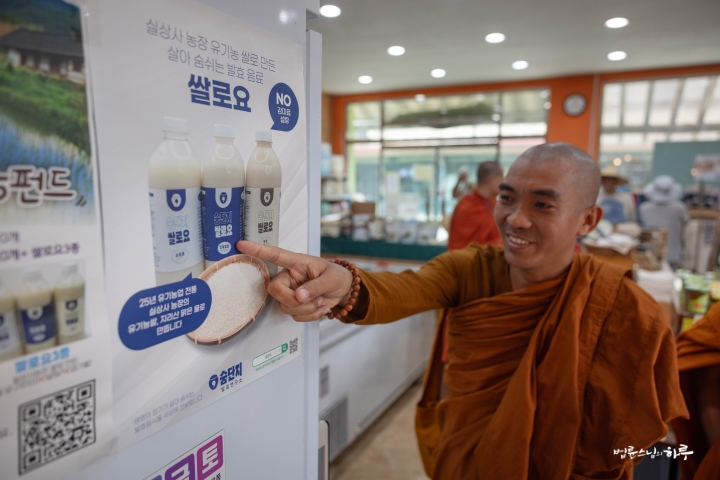
From 2 PM, they gathered at Seonjae House for a dialogue with activists working at Silsangsa Temple. First, Venerable Seungmuk, the abbot of Silsangsa Temple, introduced the work of the Indra’s Net Life Community.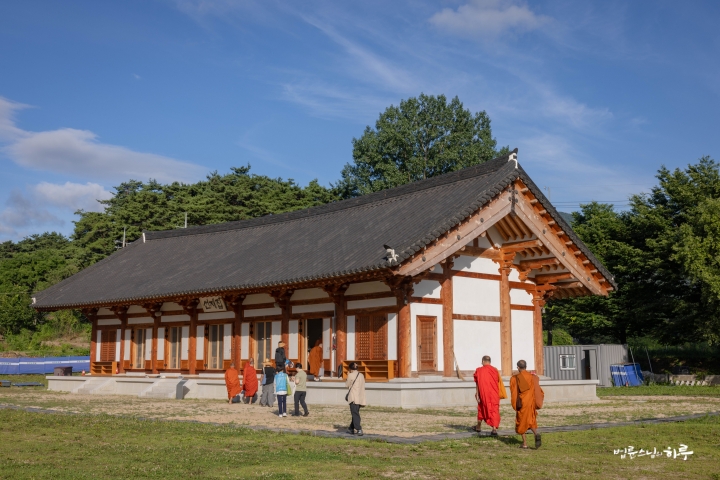
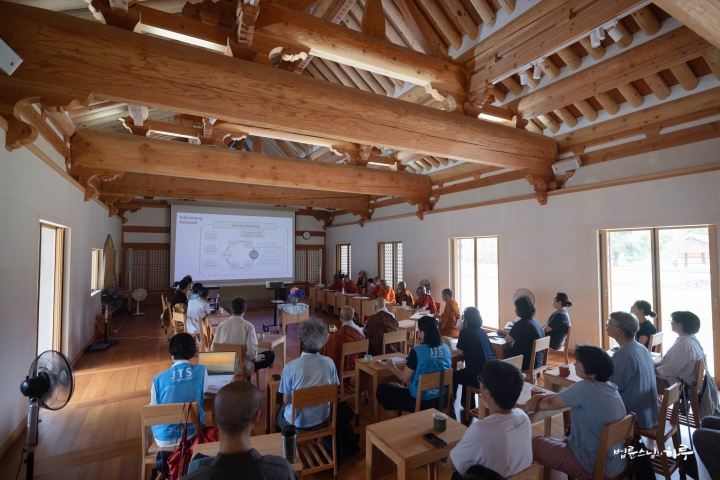
“We can be called one body, one life, a life-peace community, an Indra’s Net Life Community, all living connected together. Based on this philosophy, centered around Silsangsa Temple, we operate organically connected with the village through the farm, small school, Life Peace University, Sumdanji Fermentation Research Institute, and One Life (local activity group). We operate a community practice day every Wednesday, combining communal work and study. We practice ecological living through organic farming, hand rice planting, kimchi making, and operating ecological toilets. We run various educational institutions including Silsangsa Small School, Life Peace University, after-school programs, and daycare centers. To realize a sharing economy and ecological culture, we operate a recycle shop, Sallaejang (village market), bicycle workshop, and Women Farmers’ Center. The Silsangsa fourfold community can be called a farming-based practice community. Under the name ‘Jirisan 10,000-Day Practice,’ we have been conducting a civilization transformation movement centered on life and peace for 10,000 days since 2020. We have a vision to transform from the existing civilization of greed, discrimination, and killing to a civilization of nurturing, equality, coexistence, and enlightenment. Silsangsa values not special practice methods but life practice where daily life and work become practice itself.”
He explained in detail the philosophy, organizational structure, practical activities, civilization transformation movement, and Buddhist practice perspective of the Indra’s Net Life Community.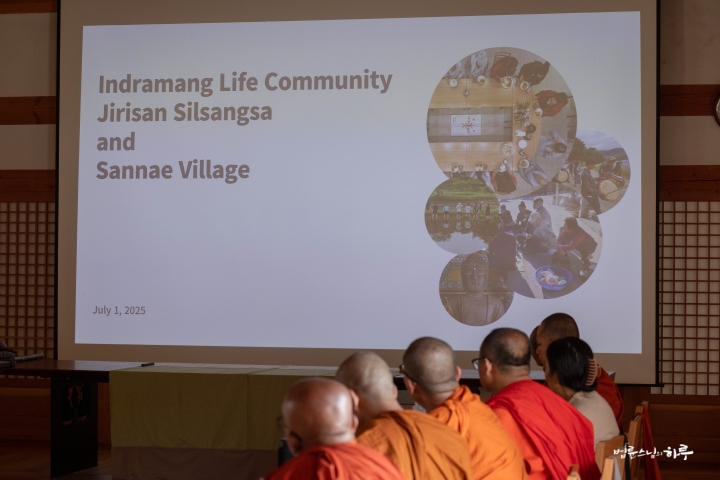
Next, Venerable Dobup, the spiritual leader of Silsangsa Temple, spoke about the values pursued by the Silsangsa fourfold community.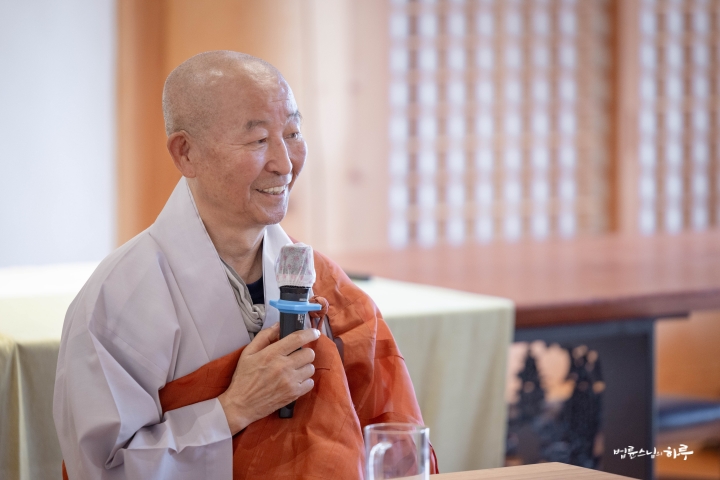
“Thank you for coming all the way to Mt. Jiri and Silsangsa Temple to seek a more desirable Buddhism and a better tomorrow. We are currently working hard at Silsangsa Temple to contemplate Buddhist alternatives and operate the fourfold community more completely. We are also striving to cultivate the Sannae-myeon village community where Silsangsa Temple is located.
Why Are We Trying to Create a Village Community?
At this point, I would like to ask myself and all of you who have joined us today these questions: ‘Why do we aspire to a fourfold community?’ or ‘Why are we trying to create a village community?’, ‘For what purpose?’, ‘For whom?’ While posing these questions, I would like to briefly discuss the question ‘For what purpose?’ If you look above, behind me where you are looking, you will see the ‘Life Peace Pattern’ enshrined. This Life Peace Pattern explains that my life here and now is formed by participating in and relating to all tangible and intangible things existing in the entire universe.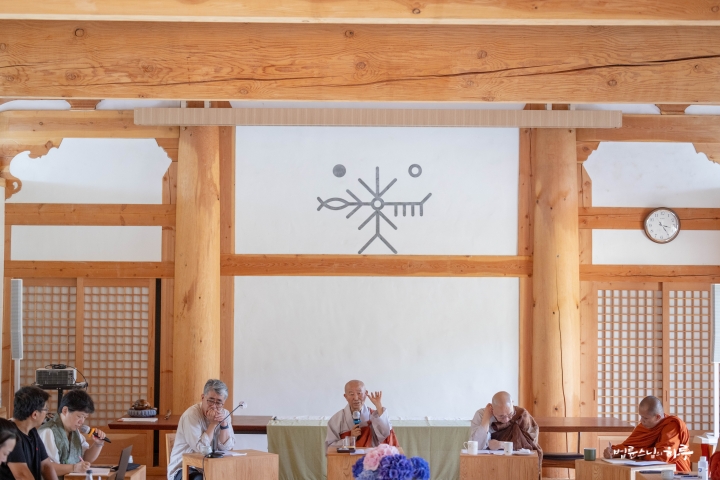
On the surface, there may appear to be a thousand or ten thousand different paths. However, the path where we can live humanely and become happy together peacefully is ultimately one. The Buddha expressed this path as ‘the path of wisdom and compassion.’ The reason we aspire to a fourfold community at Silsangsa Temple and dream of the Sannae-myeon village community together is the same. In Buddhist terms, it contains the intention to realize a life of wisdom and compassion in our lives. I hope this gathering will blossom into a good karmic connection as fellow practitioners walking this path together.”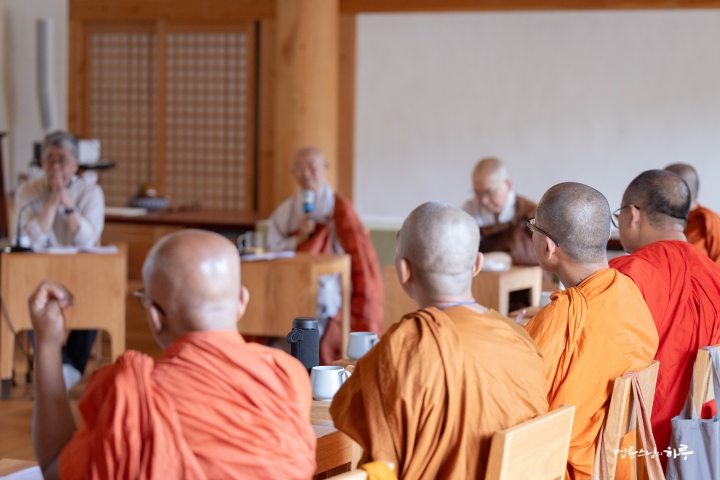
Following this, Venerable Pomnyun Sunim expressed gratitude to the Silsangsa community members for arranging today’s gathering and then introduced the INEB participant monks one by one.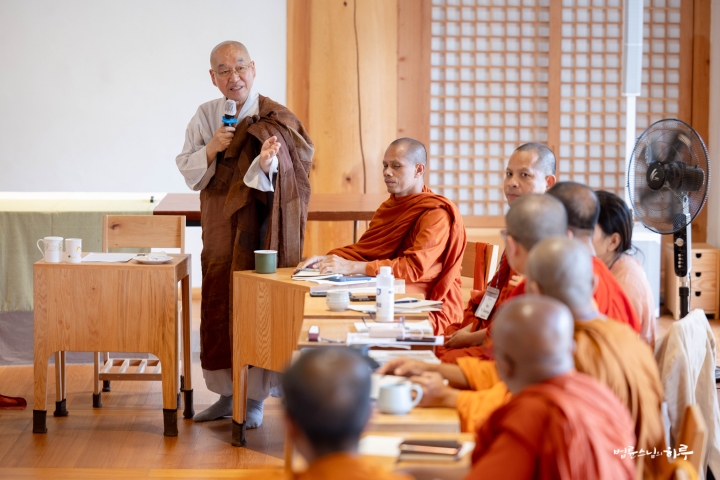
“Members of the Silsangsa fourfold community, it’s wonderful to meet you. Thank you for warmly welcoming our INEB monks. Since these monks also have temples in rural areas, the experience here will be very helpful. Most of them have visited Korea at least once before. They are currently touring, presenting and sharing their respective activities. Although this is their first visit to Silsangsa Temple, I believe it will be very helpful in the future. Thank you once again for your warm welcome and guidance.”
As he introduced the monks from each country one by one, the Silsangsa community members welcomed them with enthusiastic applause.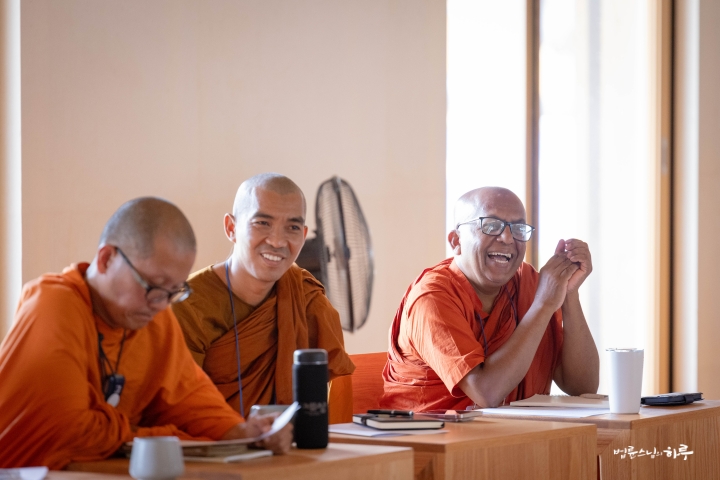
Next, questions were taken about any points of curiosity. The INEB participant monks asked various questions about the work being done at Silsangsa Temple.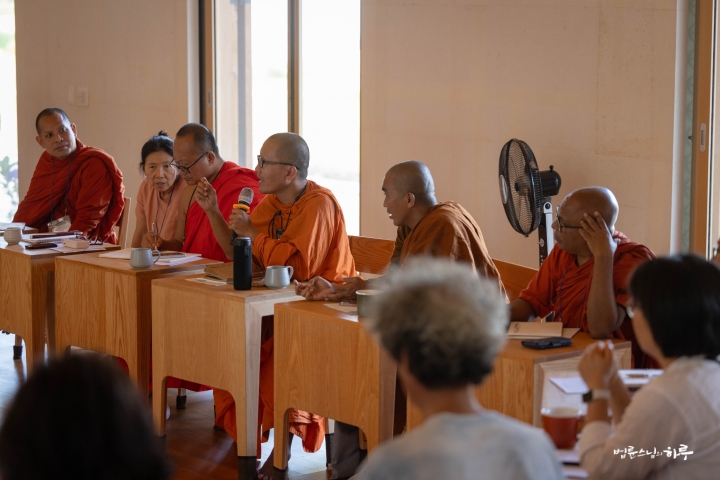
What process did the Silsangsa community go through to be created, and were there any difficulties in the creation process?
When new people come, are there processes they must go through or fees they need to pay?
What is the educational content of Silsangsa Small School by age group? How do you view sustainability given the declining enrollment?
What kind of education do the activists working at Silsangsa Temple receive?
Does the government provide any assistance? Do you have plans to overcome the declining population returning to farming?
Are there any lay practitioners at Silsangsa Temple who have become Dharma Teachers without being monks?
It was mentioned that rice farming is widely practiced here. Are there any distinctive techniques being employed?
Rice yogurt is being produced here. Was this technique first developed at Silsangsa, or are similar methods found in other countries as well?
The Q&A session continued for four hours, during which a detailed explanation was provided on how the temple works in collaboration with the local community.
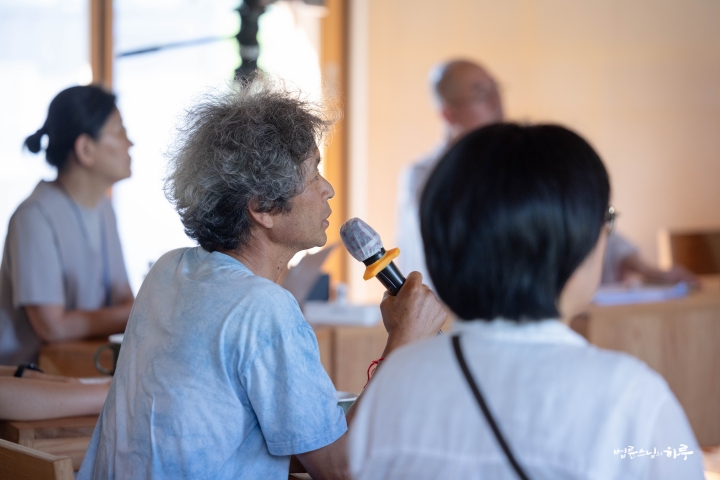
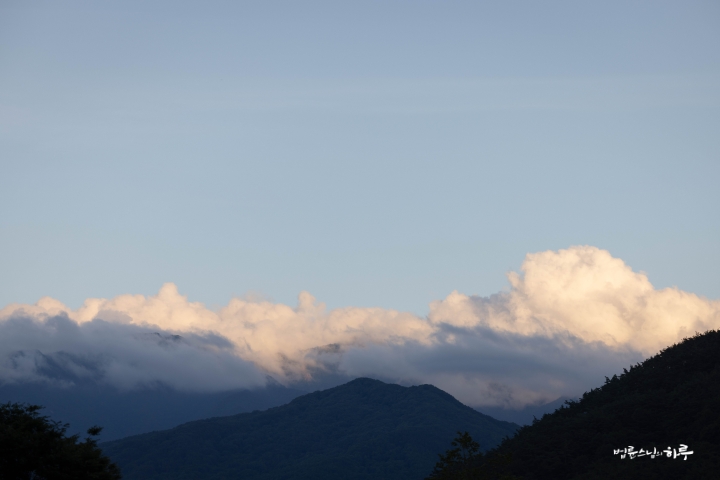
Dinner began at 5:30 p.m. After a light snack and refreshments, Sunim joined the evening chanting ceremony at Bogwangjeon Hall with the resident monks of Silsangsa Temple.
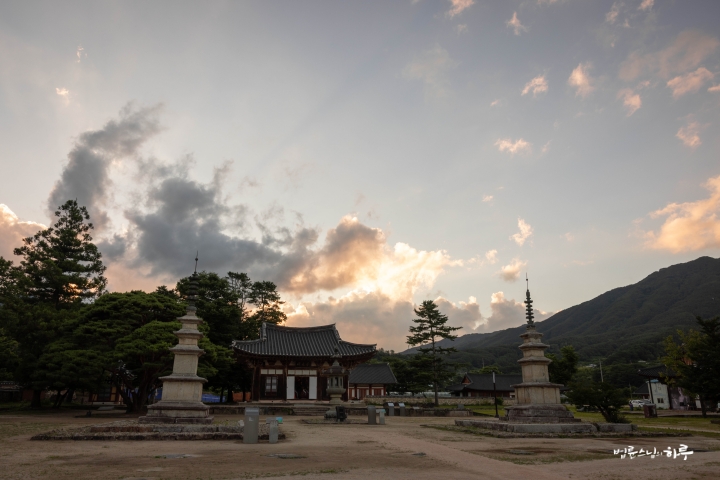
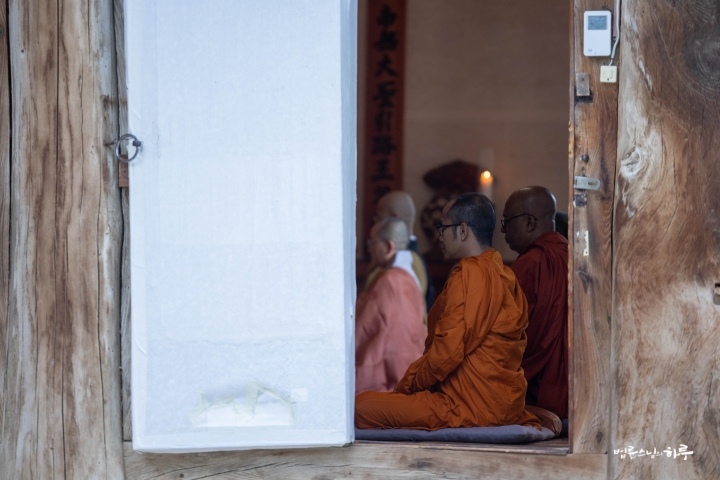
As the sound of the temple bell quietly resonated through the grounds of Silsangsa, the bustle of the day came to a pause, and a calm settled over everyone’s hearts.
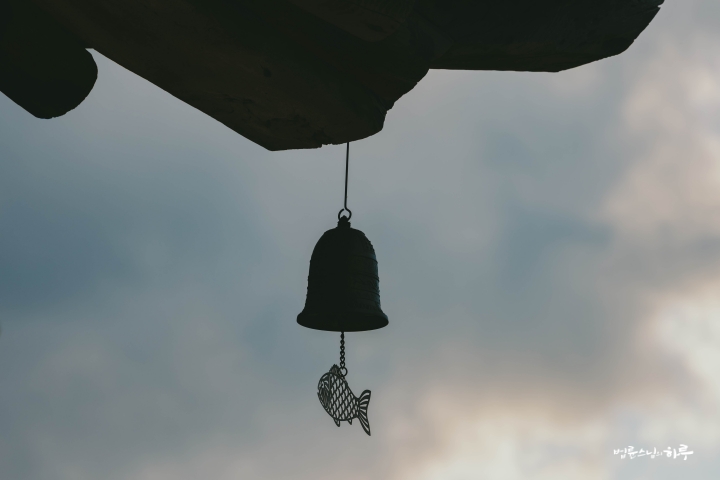
As Sunim came out of Bogwangjeon Hall after the evening chanting, the sun was setting quietly over Seonjae House. At 7:30 p.m., he led an open discussion where participants freely shared their reflections on their visit to Silsangsa and asked questions they had for one another.

Sunim began by giving a brief introduction to Silsangsa Temple.
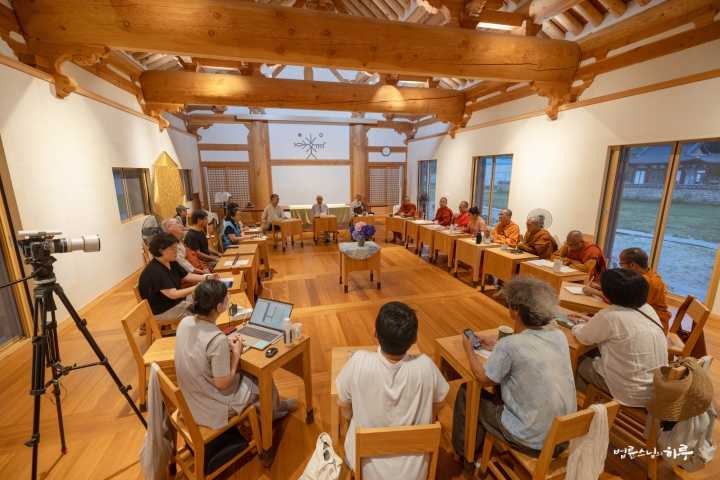
“Silsangsa is a traditional temple with a history of 1,200 years. It houses many cultural relics protected by the government. The spacious surroundings are very pleasant, aren’t they? Although it is surrounded by mountains, unlike most mountain temples, it is located on flat land.
Originally, monks lived at Silsangsa. When Venerable Dobub first came here, he determined that the monks needed to adopt a new approach to practice. Centered on the monks, he initiated a new Gyeolsa movement. This was an effort to reform the Jogye Order with a sense of purpose similar to yours. Believing that the order could change only if the monks cultivated a renewed spirit of practice, he led a movement of dedicated practice and commitment here.
At the same time, monks who studied Theravada Buddhism to gain a deeper understanding of fundamental Buddhism stayed here to conduct research. Since most Theravada scriptures in Korea exist in Classical Chinese, much of the work involved translating them from Chinese. However, here they worked extensively on translating the Pali scriptures directly into Korean. That is why your visit here can be seen as a meaningful connection.
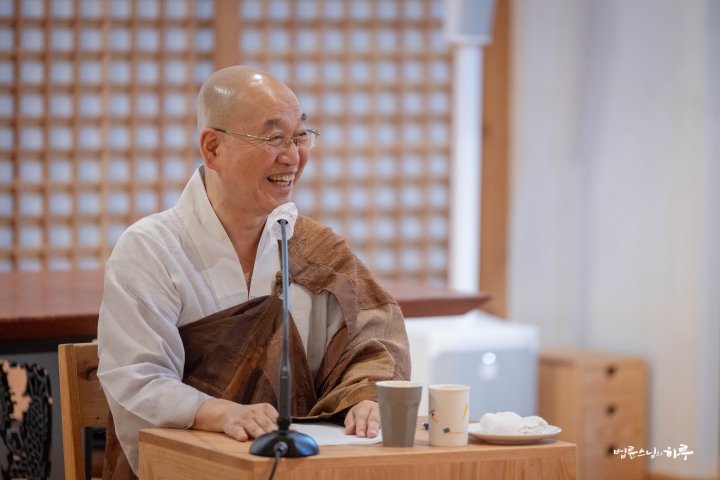
A Temple That Breathes with the Village, and the Lessons Within
This is also the temple where Seon Buddhism first arrived in Korea. It’s a place that established a farming school and initiated a back-to-the-land movement to form a community with the surrounding villages. As a result, many people who returned to farming have settled here and taken root in the local community. While most traditional Korean temples are located in rural areas, it’s rare for them to be deeply rooted among local residents. That’s why there’s particularly much for you to learn here. With this background in mind, if you ask questions or share your concerns based on what was mentioned earlier, those who have accumulated extensive experience at Silsangsa Temple will be able to offer you advice.” 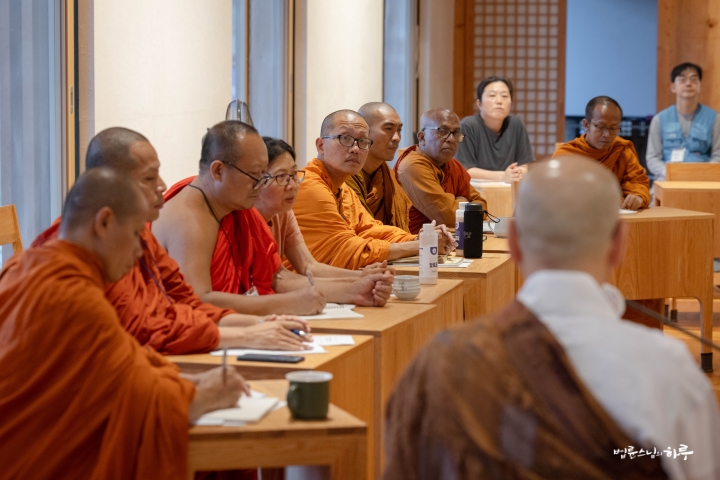
Following this, monks from various countries shared their impressions after visiting the Silsangsa community and conversing with the activists.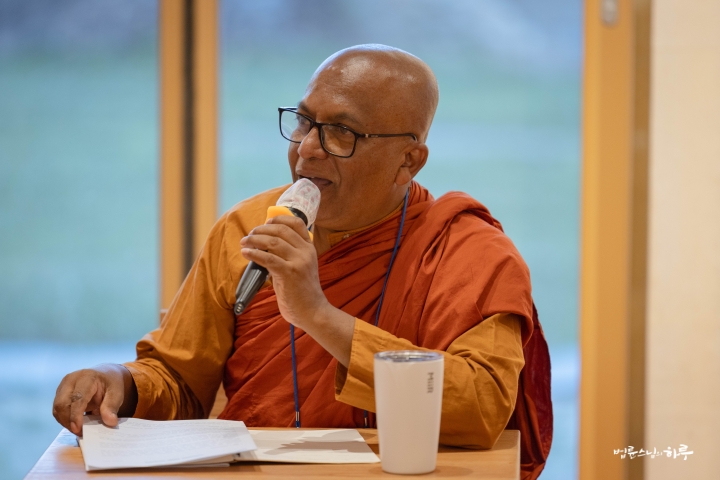
“The mountains surrounding us on all sides, the tranquil environment, the artifacts of the traditional temple, and each aspect of the monks’ prayer ceremonies left a deep impression. I was particularly amazed at how concepts like ‘Paticcasamuppāda (dependent origination)’ are integrated into the very simple and everyday life of this community. This form of Buddhist practice was a refreshing shock to all of us.” – Ven. Dhammananda (Sri Lanka)
“In our region, villagers build temples and invite monks to stay, but here the relationship is much deeper and more organically connected. I was particularly impressed by how the values and philosophy of the community shown at Silsangsa have permeated into each individual’s heart.” – Ven. Kongsin (Thailand)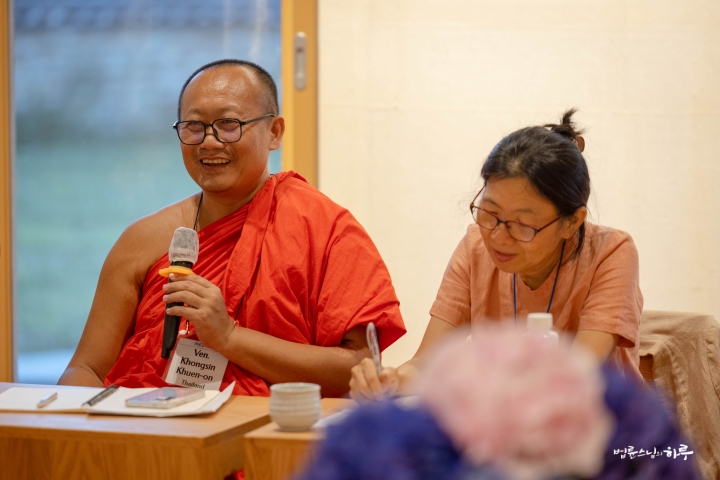
“Young people don’t come to temples these days. They’re busy with school classes, private academies, games, and mobile phones. That’s why we created the ‘Dhamma School Foundation’ in 2012, aiming not only to teach Buddhist teachings but also to reconnect with the local community. However, people sometimes misunderstand, thinking we only want to teach Buddhism. I think Silsangsa here is a good model that has gone beyond such misunderstandings and harmoniously connected with the community.” – Ven. Kittisara (Myanmar)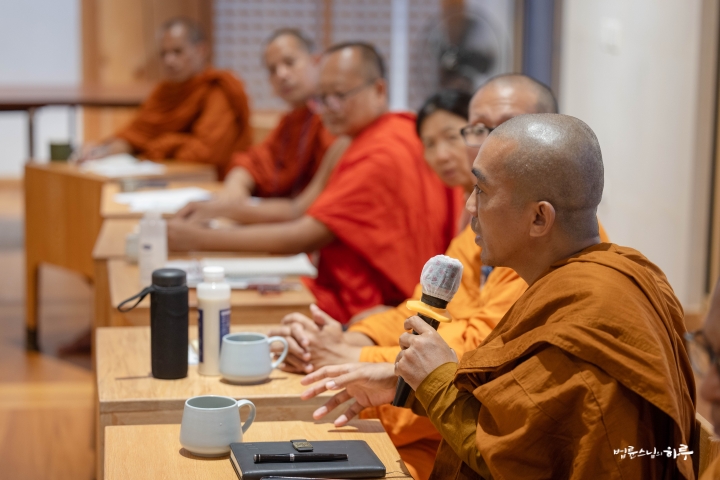
“In our country, it’s rare for monks to participate in farming or social activities, but at Silsangsa, I was moved to see monks living as members of the community, cultivating rice fields with the locals and running schools. I also want to learn more and practice so that young people in Cambodia can grow into ‘real citizens, real Buddhists.'” – Ven. Sovichia (Cambodia)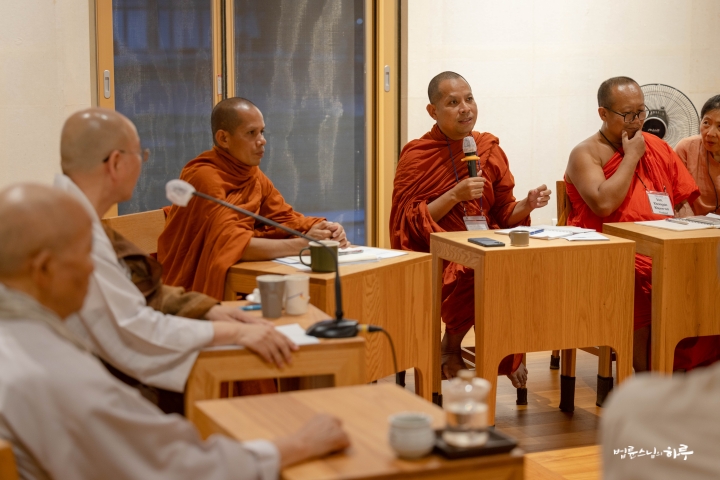
“When I first looked at the materials you shared, they seemed too abstract and I doubted whether they could be realized. But after touring the site and seeing the practices in action, I became convinced that ‘this is something we can actually do.’ In Laos, there have been many attempts to create communities that observe the Five Precepts, but they haven’t been successful. Seeing a case that has actually succeeded like this gives us courage that we can definitely do it too.” – Ven. Sayadej (Laos)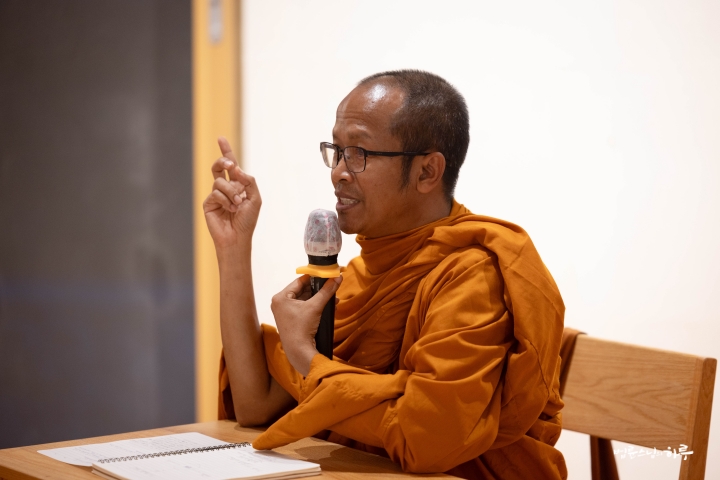
“The way Buddhism becomes one with the local community gave me deep resonance. I think this model would be possible in Cambodia too, and seeing monks living together with the region reminded me of the Buddha’s teachings.” – Ven. Phokvan (Cambodia)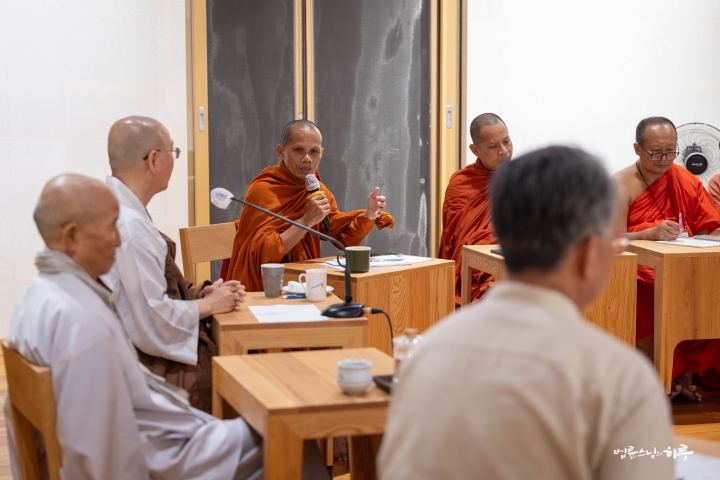
“In the rural area where our temple is located, poverty, debt problems, and environmental issues are serious. I wondered if there were such problems here too. But I heard that because community members live frugally and don’t pursue material things, villagers actually don’t come asking for help. This was impressive. I also felt the warmth of the community in seeing a traditional Korean medicine doctor providing free treatment in the community.” – Ven. Prawin (Thailand)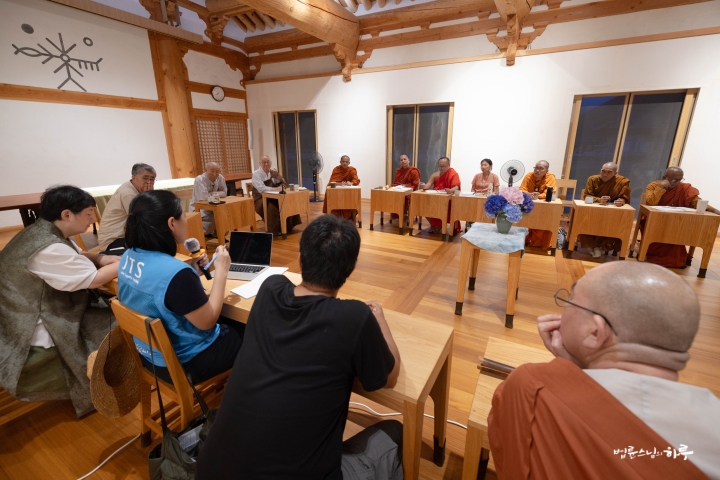
The INEB participant monks were deeply impressed by the organic relationship with the local community and the sustainable practices shown by the Silsangsa community. They expressed their determination to reference this model and reorganize Buddhist communities in their own regions.
After the sharing session ended, a Q&A session continued for questions about the operation of the Silsangsa community.
Ven. Dhammananda pointed out the large distance between monks and laypeople in Theravada Buddhist culture as a problem and asked how Silsangsa had broken down those barriers. Ven. Dobup responded: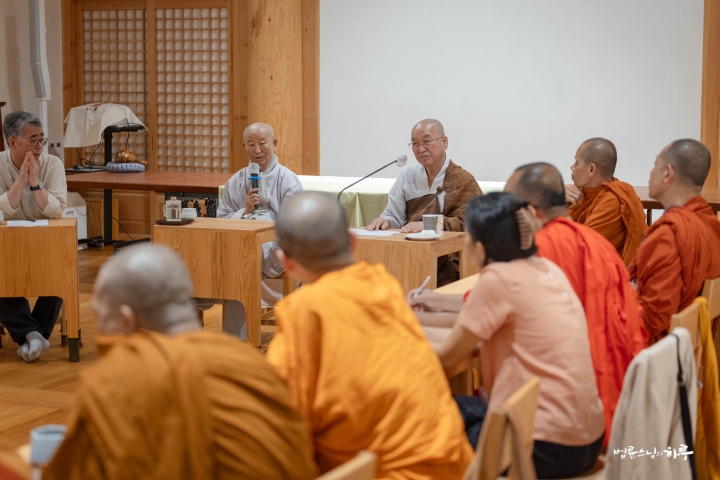
“In the process of genuinely encountering people during pilgrimages, I learned that ‘how sincerely we meet’ is more important than ‘whether we share the same religion.’ So we created a culture and system in our temple where equality becomes a way of life.”
Ven. Prawin mentioned the reality of farmers suffering from debt and asked about Silsangsa’s response. When Operations Director Jung Woong-gi replied, “There are certainly people in debt in this rural area too, but no one has come to Silsangsa asking for help with debt problems,” Sunim added with a smile:
“Because Silsangsa members live frugally, residents can’t ask to borrow money. When borrowing money, people tend to ask those who appear to be economically better off than themselves.” (Laughter)
Ven. Sayadej asked if there were medical activities within the community, and Silsangsa responded that one of their community members is a traditional Korean medicine doctor who provides weekly consultations, caring for both community members and local residents.
As the conversation was reaching its peak, it was time to conclude. Finally, Sunim briefly explained the differences between Silsangsa and Jungto Society.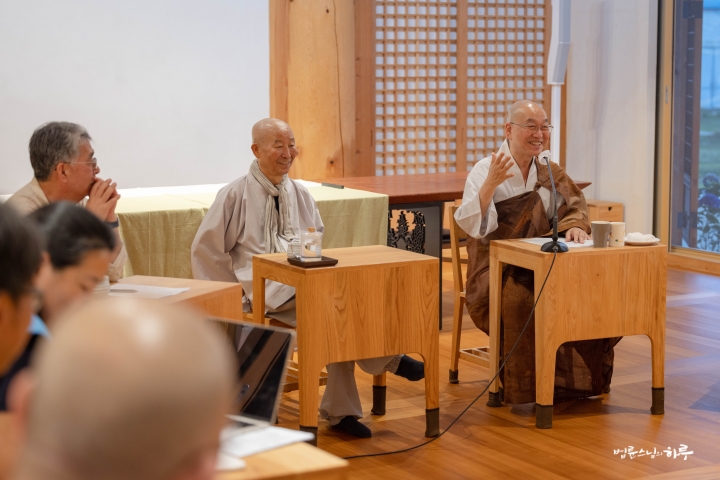
“In Korea, there’s a saying: ‘When a house is very old, it’s easier to build a new one than to repair it.’ This means that repairing can cost more money and be more difficult than building new. For example, Jungto Society is a case of building new. On the other hand, Silsangsa is a case of renovation. Actually, renovating is much more difficult. Creating new hope for Buddhism while renovating, preserving tradition, and working with residents is really hard work. In my opinion, given the environment and culture you live in, it would be more appropriate to move toward renovation rather than building new. But renovation is never easy. In that sense, I ask for a big round of applause for Ven. Dobup and all the fourfold assembly of Silsangsa who have done such a good job renovating Korean Buddhism.” 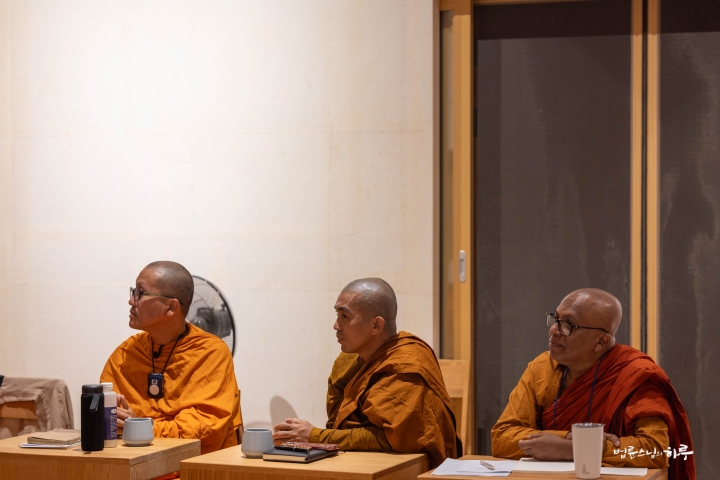
Venerable Dobeop also added a few words.
“I’ve been watching for the past 30 years and have always felt one regret. If Korean society had paid more attention to rural issues 20 years ago, we could have prevented the current situation and opened up a more desirable path together. Listening to your stories today, I urge you once again: please don’t wait too long to find alternatives in your own countries. That path will be the most desirable one in many ways.”
As the night grew late, the conversation had to come to an end. The INEB participant monks who visited Silsangsa Temple today deeply resonated with the idea that “Buddhism should not remain as an ideal or philosophy but should be practiced in daily life.”
After leaving Silsangsa Temple, Sunim got in the car and headed back to Seoul. He needs to conduct a live broadcast of the Weekly Dharma Assembly in Seoul tomorrow morning. The INEB participant monks decided to stay overnight at Silsangsa Temple and continue their exchange with the temple tomorrow morning.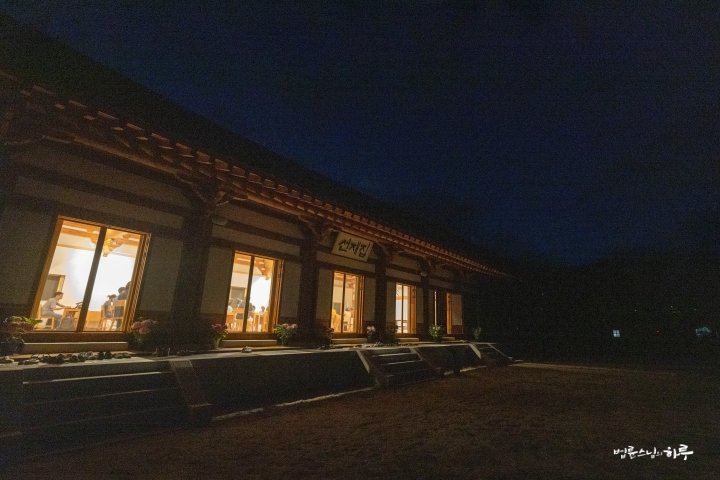
After a three-hour drive, Sunim arrived at Seoul Jungto Center at midnight and concluded his day.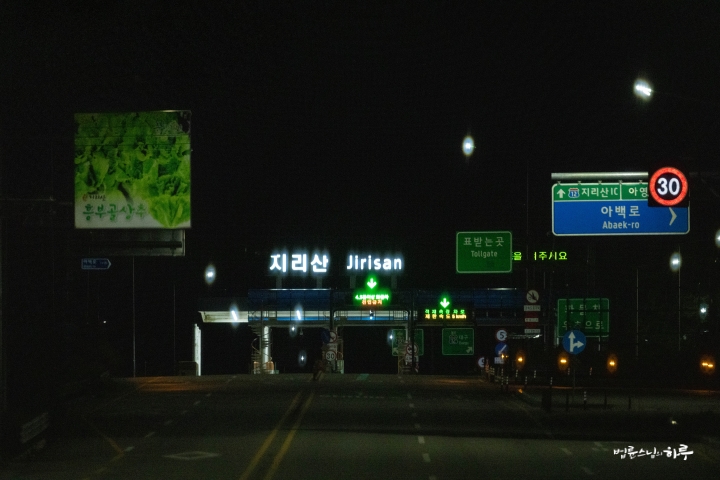
Tomorrow marks the seventh day of the INEB study tour. In the morning, Sunim will conduct a live broadcast of the Weekly Dharma Assembly for Jungto Society members, and in the afternoon, he will continue dialogues with INEB participant monks at the Jungto Social and Cultural Center in Seoul.



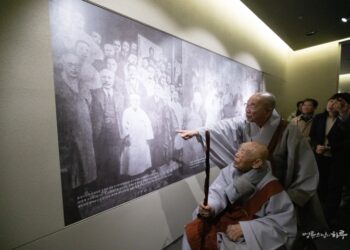
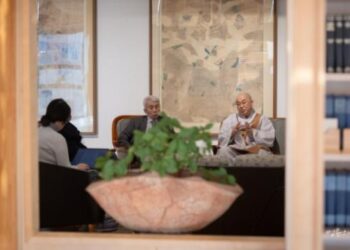

Thank you for this wonderful article. I am grateful to the venerable monks for creating a better model for human life.